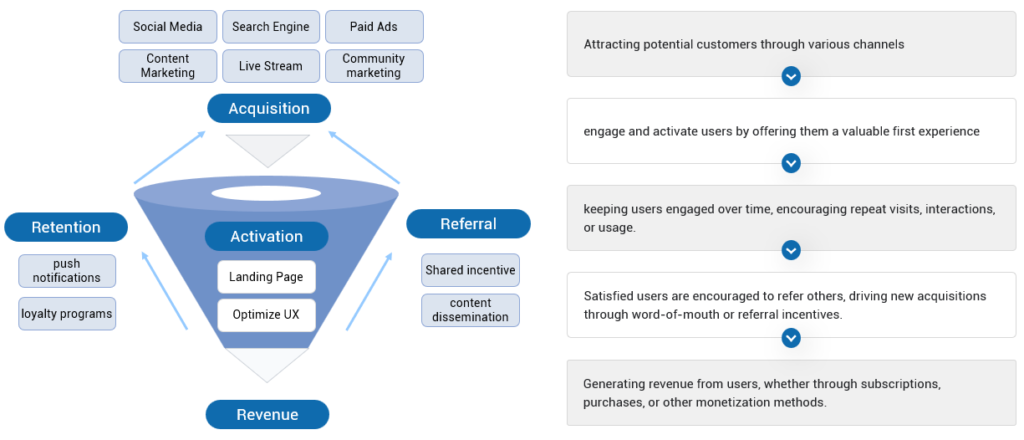The AARRR model, also known as the Pirate Metrics framework, was introduced in 2007 by Dave McClure. This model is widely used in growth hacking and digital marketing to optimize the customer journey and drive business growth.
Standing for Acquisition, Activation, Retention, Referral, and Revenue, the AARRR model provides a structured approach to measuring and improving key stages in a customer’s lifecycle.
How the AARRR Model Works
Acquisition
The journey begins by attracting potential customers through various channels, such as social media, SEO, content marketing, or paid ads. The focus is on bringing users to the brand’s website, app, or platform.
Activation
Once acquired, the next step is to engage and activate users by offering them a valuable first experience. This could mean signing up, creating an account, or taking an initial action that demonstrates interest.
Retention
Retention focuses on keeping users engaged over time, encouraging repeat visits, interactions, or usage. Strategies might include personalized content, push notifications, or loyalty programs that keep users coming back.
Referral
In this stage, satisfied users are encouraged to refer others, driving new acquisitions through word-of-mouth or referral incentives. This turns happy customers into advocates, helping to expand the customer base organically.
Revenue
The final stage is generating revenue from users, whether through subscriptions, purchases, or other monetization methods. This stage measures the model’s overall effectiveness in converting and retaining paying customers.
Why the AARRR Model is Effective for Growth
The AARRR model is especially valuable in digital marketing and growth hacking because it focuses on measurable actions at each stage. By tracking metrics like acquisition cost, activation rate, retention rate, referral impact, and revenue, brands can identify which parts of the funnel need optimization. This data-driven approach allows for targeted improvements, ensuring steady growth and long-term customer loyalty.
To effectively use AARRR, brands should set up analytics to track performance at each stage, identify bottlenecks, and develop strategies to improve weak points. This model’s focus on actionable metrics helps businesses optimize each stage of the customer journey, from acquisition to revenue, fostering sustainable growth.
Shifts from Previous Marketing Model
When marketing shifted from AIDMA, AISAS to AARRR, several key changes emerged, reflecting a transition from broad digital engagement to a more data-driven, growth-focused approach. Here’s how these models differ and what changed:
Focus on Data and Measurable Metrics
AARRR is designed to measure each stage of the customer lifecycle through specific metrics (e.g., acquisition rate, retention rate, revenue generated). This shift allows companies to quantify and optimize each stage based on data, facilitating a more scientific approach to growth.
From Broad Audience to Targeted Customer Segments
AARRR emphasizes customer segmentation, targeting high-value users who are more likely to convert, refer others, and generate revenue. This approach allows for more tailored marketing efforts.
Business Case
Dropbox’s Referral Program
Dropbox effectively used the AARRR model to achieve rapid growth, especially through its famous referral program:
- Acquisition: Dropbox initially attracted users through targeted online ads, word-of-mouth, and organic search.
- Activation: New users received a seamless onboarding experience with a quick setup and free storage, which highlighted Dropbox’s value.
- Retention: Dropbox encouraged users to store files and sync them across devices, which kept users engaged and coming back.
- Referral: Dropbox’s referral program offered both the referrer and the referred friend additional free storage. This powerful incentive turned users into advocates, significantly boosting referrals and acquisition at a low cost.
- Revenue: As users increased their storage needs, Dropbox encouraged them to upgrade to premium plans, converting free users into paying customers.
Spotify’s Freemium Model
Spotify’s freemium model leverages the AARRR model to engage and convert users effectively:
- Acquisition: Spotify attracts new users through social media marketing, partnerships, and search engine visibility, providing an easy, free sign-up option.
- Activation: New users get an immediate taste of Spotify’s vast music library with a free tier that offers value without commitment.
- Retention: Spotify’s algorithm-based recommendations, playlists, and personalized content help keep users engaged daily, improving retention.
- Referral: Spotify encourages sharing through social media integrations and collaborative playlists, making it easy for users to share music and playlists, thereby driving more sign-ups.
- Revenue: Spotify’s free tier encourages users to upgrade to the ad-free premium version, unlocking additional features like offline listening. This freemium approach drives steady revenue growth as users transition to paid plans.
Unlock all frameworks and templates
Unlock exclusive thinking frameworks and practice templates.
Become a member to access all premium content to elevate your thinking!
The Evolution of Marketing Model
| Model | Focus Area | Journey Stages | Best For |
|---|---|---|---|
| AIDMA (1898, E. St. Elmo Lewis) | Traditional Offline Marketing | Linear, memory-focused stages | Branding in traditional media |
| AISAS (2005, Dentsu Inc) | Digital Consumer Behavior | Adds “Search” and “Share” | Digital marketing and e-commerce |
| AARRR (2007, Dave McClure) | Growth Hacking and Startups | Metrics-based funnel | SaaS and digital businesses |
| AIPL (2017, Alibaba Inc) | E-commerce & Retail | Simpler journey, loyalty-focused | Tracking e-commerce conversions |
| 5A (2022, Philip Kotler) | Digital-Age Holistic Journey | Emotional appeal, customer research, advocacy | Omnichannel modern marketing |
Template for Practice
Get into the real practice now.

Available in the Templates
Go to Templates to download the resource.

